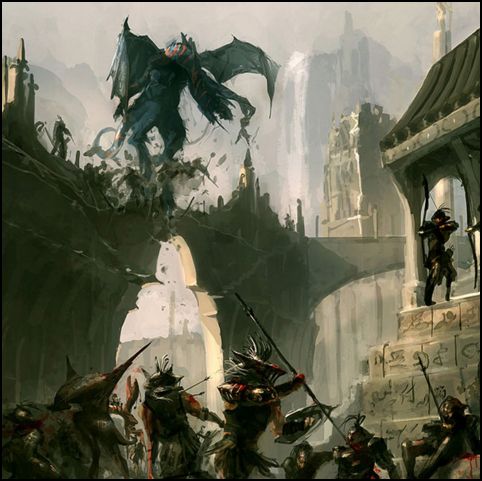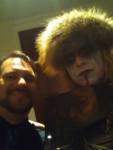
When I started my first novel, Consequences Within Chaos, I fell into an almost obsessive “plot mode” and wrote a rather long, bulleted outline of my story (60 pages to be exact). However, for the battle scenes, I skipped past with a lazy wave of the hand and just wrote a line “insert battle scene here.” Not giving the battle scene its proper respect was not only a big mistake as far as outlining, but it also became a huge stumbling block for me when I attempted my first drafts.
Why?
Well, when it came time to write these epic battles, I found I had no real idea where to start. Instinctively, I knew that there was a lot riding on capturing this part to my story just right. I had lied to myself and naively thought that this would “all magically be revealed and come naturally to me”.
Suddenly with all that sitting upon my shoulders, I put off writing the first one; even postponed and put aside the book for months. I wouldn’t categorize this period as writer’s block, but maybe a weird version of stage fright? If I didn’t write the scene (didn’t walk out upon the stage), then I wouldn’t screw it up (I wouldn’t show how bad I was at this) and embarrass myself (fall flat on my face in front of the audience).
It took me a lot of research, experimentation, rewrites and some sheer will to get the battles done for the book. They’re not perfect, but I am happy with them overall. Will I do better nowadays? I sure hope so!
To save you from my pain, here are the critical factors you need to answer when using a battle scene (this includes all types of fights – barroom brawls, ambushes, street assaults and all the way to the epic, five army battles!):
- Determine who is all involved (Characters/groups) – this includes not just your main characters or protagonist and any friends, but it includes the antagonist (most times) and/or his minions or allies. Also keep in mind any surprise attendees you may want to include. This will add to the tension of the scene!
- Provide goals and personal motivations for all parties (Individual beliefs) – you will need to ask yourself why you are doing this battle. Ask yourself if the battle is really important to the overall story (in other words, don’t include it just to have an action sequence). Also ask what reasons and goals does each character have for the battle. Make them have an invested motive to being there. What do they have to lose being there or what do they need to achieve? Here is a great chance to really highlight a person’s inner thoughts. Showcase their strengths, courage or lack thereof. And be sure that their reasons are not the same for each battle and you are not just repeating what you have already accomplished.
- Decide where the battle will take place (Setting) – this important step can elevate your scene to that next level. Backgrounds can be key elements that bring the scene to life. If the battle takes place in a cliché or too common landscape then the scene might come across as redundant or even predictable. For example, look at the epic fight scene between Annakin Skywalker and Obi-Wan Kenobi in Star Wars III: The Revenge of the Sith. The frantic battle between the two characters was incredibly more entertaining due to tension of having their duel upon pieces of debris in a lava flow. The battle was a highlight for this film (as there were very few that I can think of). If the battle was just on a large open field, the scene would not have stuck in your mind. However, use caution as there is a fine line between entertainment and disbelief!
- Orchestrate the exact movements and attacks (Pace) – here you must be careful with the “dance steps” of the battle. Who moves where and who reacts to what. It is very important to write the actions carefully so as to not be choppy (which happened with my first attempts) and has to be clear so that the reader isn’t confused. Remember they cannot actually see it and are relying on your words to paint the proper picture. Also in order for the prose to be read smoothly and the pace of the combat to be in line with the action, use short terms, small paragraphs and simpler words. The whole hope is to have the readers become immersed, have their breaths taken away and have them on the edge of their seats trying to figure out what’s going to happen next. If they are reading through intricate details, lengthy descriptions or wordy dialogue, they are not going to experience the same impact that they would with tighter pacing.
- Include at least one unexpected event or tactic (Conflict) – as a rule for myself, I try to bring a creative element to the battle that the readers as well as the characters were not expecting. It heightens the tension of the whole scene. In the movie Braveheart, they added often many twists to their battles that caught the viewers and the combatants by surprise. During one battle that comes to mind, when the English were charging on horseback with swords held high and ready to trample the foot soldiers of Wallace’s armies, the Scots suddenly brought up spears that were hidden within the tall grass! While the unfortunate horses paid the price mostly for this trick, this simple twist changed the whole expected outcome.
- Plan for and carry out the results (Outcome) – when you start designing the battle, be sure you know what you are getting for each side and be sure you what you really want for your plot and story. Many writers have written themselves into a deep corner because they didn’t think ahead to the outcomes. They focused so much on the battle that they didn’t plan for the results. Your battles should serve you! Whether the results pin your main character down even harder (which is great – the farther the point where the character has to come back from, the more tension and conflict it brings to the story) or whether they actually win at last what they have been struggling to obtain the entire story, battles are stepping stones for your characters. Battle outcomes are pivotal and vital to the future of the story and it can be disastrous to lose focus on that.
Every scene is a platform for your character to level up and grow in the direction you need them to in your story. Their triumphs or losses are the very ingredients that make up who they are. Just like us in every day life – if we don’t experience ups and downs then we do not grow from them or learn from the journey.
Writing a battle scene can place your character under intense scrutiny, pressure to succeed and motivate him or her to excel – without this extreme moment of their life they would not have achieved anything your story wants and needs them to accomplish.
For us as writers, battles are waged and won with swords and words!














